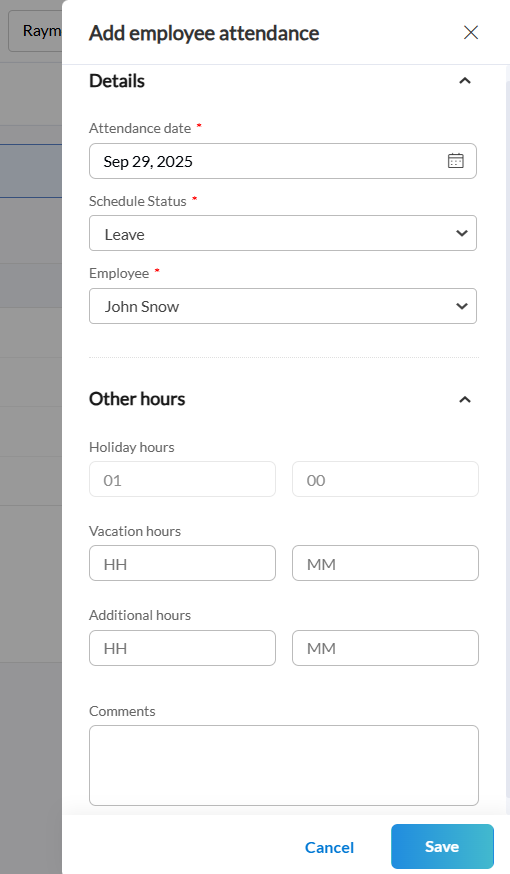Record non-working hours for employees
This article explains how managers can record holiday, vacation, and other time-off hours for employees using the Manage Check-in screen. It also details how employee schedule status affects visibility in the employee list, when schedule fields are disabled, and how time-off entries are handled in the system.
Overview
Managers can log holiday, vacation, and additional hours for employees without needing to enter check-in or check-out times, depending on the employee’s schedule status. The process ensures flexibility while maintaining accurate tracking and reporting of paid non-working hours. Time-off data is reflected in attendance reports but is not included in overtime or total working hour calculations.
Key terms
Vacation Hours: Paid time off for personal leave.
Holiday Hours: Paid hours granted for holidays, whether the employee worked or not.
Additional Hours: Paid time recorded for other approved leave types (e.g., sick leave).
Schedule Status: A tag assigned to employees in the Employees > Schedule screen to reflect their working or leave state.
Manage Check-in Screen: The interface used to enter check-ins, time-off hours, or modify attendance records.
Prerequisites
Only managers can record or modify time-off hours.
The employee must be active and assigned a Schedule Status in Employees > Schedule.
The schedule status determines whether the employee appears in the employee dropdown.
Scenarios
A stylist on vacation can be paid for the vacation hours without any check-in.
A stylist working on a holiday can be paid both for worked hours and holiday hours.
A stylist on medical leave can be paid using Additional Hours, even without a work schedule.
To record time-off for an employee:
At the center level, click the Employee icon.
Go to Employees > Employees > Check In.
Select the date for which you want to record hours.
From the Schedule Status dropdown, select a relevant status (e.g., Leave, Working, Special Leave).
The Employee dropdown displays all employees.
Select the employee and date.
Click Edit.
If the employee has a Leave, Special Leave, or other custom leave status:
Expected Check-in, Expected Check-out, Actual Check-in, and Actual Check-out fields will be disabled (greyed out).
You can only enter Vacation Hours, Holiday Hours, or Additional Hours in HH:MM format.
If the employee is scheduled to work:
All fields will be editable, including schedule and time-off hours.

Click Save.
Considerations
Schedule status assigned in the Schedule screen directly controls who appears in the employee dropdown of the Manage Check-in screen.
For employees marked on leave (or similar statuses), time fields are disabled to prevent entering schedules during their time off.
You can record vacation, holiday, and additional hours independently of schedule details.
These hours are excluded from total hours and overtime calculations.
Total daily hours may exceed 24 when overlapping check-in and time-off hours are entered.
Expected Check-in/Check-out and Actual Check-in/Check-out fields are disabled for employees marked on leave.
Vacation, holiday, and additional hours cannot be edited after saving. The entire entry must be deleted and recreated.
Reports display the total of all time-off hours but do not itemize vacation, holiday, and additional hours separately.
Time-off hours are not counted toward overtime or total scheduled hours.
The employee checked in at 08:00 AM and checked out at 09:00 PM. They logged 07:00 hours as vacation and 06:00 hours as holiday hours. The total duration recorded is 26:00 hours for the day.